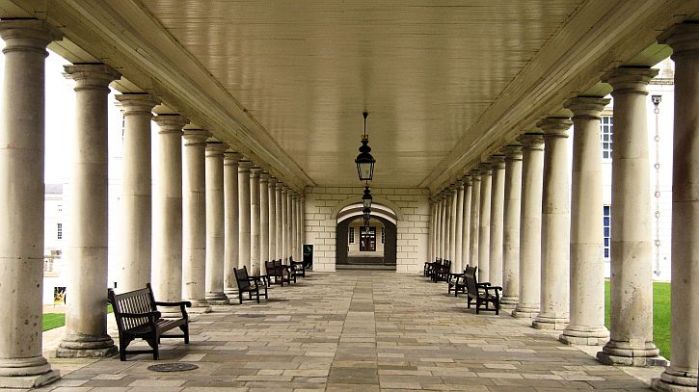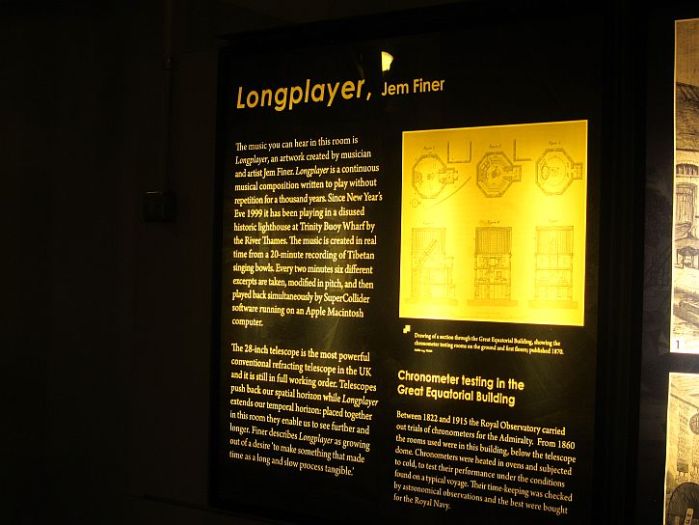The view from the north bank of the Thames
Heading for the National Maritime Museum in Greenwich, we decided to take the Docklands Light Railway, past the improbably named Mudchute, to Island Gardens, the last stop on the north bank of the Thames. We wanted to take advantage of the excellent views across the river to the complex of elegant 17th century buildings at Greenwich – Inigo Jones’ Queen’s House, and the Royal Observatory and the Greenwich Hospital for injured and disabled seamen designed by Christopher Wren.
The Cutty Sark at Greenwich with the glazed dome of the foot tunnel entrance on the right
Another attraction is that from Island Gardens you can walk to Greenwich under the Thames using the Greenwich Foot Tunnel. The tunnel was opened in 1902 to allow workers living on the south side of the Thames to reach their workplaces in the London docks and shipyards then located in or near the Isle of Dogs.
Entering the tunnel
The cast-iron tunnel is 1,215 feet long and burrows 50 feet below the river bed. Its cast-iron rings are lined with concrete which has been surfaced with some 200,000 white glazed tiles. At each end, access to the tunnel is by means of a round entrance hall with a glazed dome. There are lifts as well as steps!
The tunnel entrance at Greenwich
We emerged from the tunnel on the south side to what was originally the site of Greenwich Palace, built by Henry VII and the birthplace of the Tudor queens Mary I and Elizabeth I. Having fallen into disrepair during the Civil War, the palace was demolished and replaced in 1692 by the Royal Hospital for Seamen, a permanent home and healthcare facility for disabled sailors of the Royal Navy which operated until 1869. The building was designed by Christopher Wren, who was also the architect responsible for the Royal Greenwich Observatory up the hill beyond.
Our main purpose in coming here was to see the current exhibition at the National Maritime Musuem – Turner and the Sea (to be the subject of the next post), housed in The Queen’s House, designed by Inigo Jones for Anne of Denmark, wife of James I. Jones had recently spent three years in Italy studying Roman and Renaissance architecture. It was his first important commission and the first fully Classical building built in England. The building was completed in 1619.
The Queen’s House colonnade, a 19th century addition
After seeing the Turner exhibition, we climbed the hill to the Greenwich Observatory, commissioned in 1675 by King Charles II who also created the position of Astronomer Royal to serve as the director of the observatory and to
Apply himself with the most exact care and diligence to the rectifying of the tables of the motions of the heavens, and the places of the fixed stars, so as to find out the so much desired longitude of places for the perfecting of the art of navigation.
The Greenwich Observatory
The Observatory was the first purpose-built scientific research facility in Britain and played a major part in the history of astronomy, especially in solving problems of navigation and timekeeping. Both were critical to the development of colonisation and overseas trade in the 17th century, and representative of the Enlightenment focus on scientific method and knowledge. The Observatory is probably best known as the location of the prime meridian, and on the day we were there groups of schoolchildren were excitedly photographing other standing astride the meridian.
Astride the Greenwich meridian
If you climb the winding stairs to the upper section of the observatory, you emerge inside the onion dome which houses the 28-inch Greenwich refracting telescope; completed in 1893, it’s the largest of its kind in the UK and the seventh largest in the world. We were here for something less astronomical though, but inspired nevertheless by similar questions of time and space.
The 28-inch Greenwich refracting telescope
Entering the dome, you slowly become aware that you are hearing music of an ethereal beauty: ringing tones, bells and unearthly vibrations. This is Longplayer, a piece of music designed to last for one thousand years. It started to play at the start of the millennium in 1999, and if all goes to plan it will continue without repetition until 31 December 2999. Then it will start over again.
Longplayer was designed and composed by Jem Finer, formerly of The Pogues (he co-wrote several of the band’s songs, including ‘Fairytale of New York’, with Shane MacGowan). We had wanted to visit Longplayer ever since encountering another Jem Finer sound installation – Score for a Hole in the Ground – while walking in a wood in Kent.
Longplayer is a piece of music designed to last 1000 years without ever repeating itself, and currently exists in both online and live versions (at the Royal Observatory, inside a 19th century lighthouse at Trinity Buoy Wharf in London Docklands, and at the Science Museum. Longplayer is based on an existing piece of music, 20 minutes and 20 seconds in length, which is processed by computer using a simple algorithm. This gives a large number of variations, which, when played consecutively, gives a total expected runtime of 1000 years. The music was composed using Tibetan singing bowls and gongs, which are able to create a range of sounds by either striking or rolling pieces of wood around the rims. This source music was recorded in December 1999.
Longplayer
Longplayer reflects several of Jem Finer’s concerns, particularly relating to systems, long-duration processes and extremes of scale in time and space. Finer explains on his website that:
Longplayer grew out of a conceptual concern with problems of representing and understanding the fluidity and expansiveness of time. While it found form as a musical composition, it can also be understood as a living, 1000-year-long process – an artificial life form programmed to seek its own survival strategies. More than a piece of music, Longplayer is a social organism, depending on people – and the communication between people – for its continuation, and existing as a community of listeners across centuries.
An important stage in the development of the project was the establishment of the Longplayer Trust, a lineage of present and future custodians invested with the responsibility to research and implement strategies for Longplayer’s survival, to ask questions as to how it might keep playing, and to seek solutions for an unknown future.
As to how the long duration of the piece has been achieved, Finer says:
Longplayer is composed in such a way that the character of its music changes from day to day and – though it is beyond the reach of any one person’s experience – from century to century. It works in a way somewhat akin to a system of planets, which are aligned only once every thousand years, and whose orbits meanwhile move in and out of phase with each other in constantly shifting configurations. In a similar way, Longplayer is predetermined from beginning to end – its movements are calculable, but are occurring on a scale so vast as to be all but unknowable.
Longplayer has been playing since 1999 and will continue to play till 2999. On the 12 September 2009, 1000 minutes was performed live at The Roundhouse in London:
Leaving the Observatory, we walked back down the hill. Along the way there is a dramatic view of the City skyline, its steel and glass towers dwarfing the classically-proportioned buildings on the near bank of the Thames.
I found the view deeply depressing; it provoked the thought that here, in concentrated form, was an image that spoke of the contrast between an age of enlightenment, distinguished by scientific enquiry and the pursuit of human dignity, and one in thrall to the pursuit of wealth and the power of financial institutions (see their names emblazoned there on the towers!); between an architecture whose proportions were in tune with the human scale, and one with no humanity which subjugates humans to little more than ants. I thought of Blake’s ‘London’:
See also
- Longplayer: click ‘Listen’ to stream Longplayer live on your device
- Score for a Hole in the Ground: a visit to Jem Finer’s installation in Kings Wood near Ashford
- How to play music that lasts 1,000 years (Guardian, 2009)










Fascinating to learn about, as well as listen to, Longplayer!
Gerry,
I always save your posts but I dont always get around to reading them. I am so glad that I did this time. What an amazing piece of work by Jem Finer. Must visit next time I am in London. However depressing the final ‘view’, sometimes what we see is deceptive. surely the lot of the average human is far better than in the age of enlightenment when these wonderful buildings were built for a privelaged elite.
Deirdre
Thanks for commenting, Deidre. I agree absolutely about the human lot having improved since the age of enlightenment. I would note, however, that the towers in that view were also built for a privileged elite. But my main point was about the modern skyline being so unharmonious. I read in the Guardian this week (http://www.theguardian.com/cities/series/london-skyline-debate) that there’s a campaign to save London’s skyline.